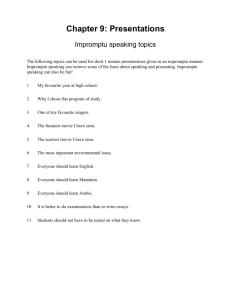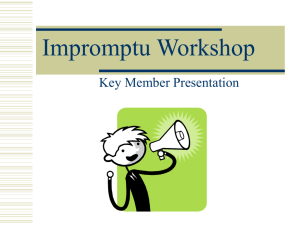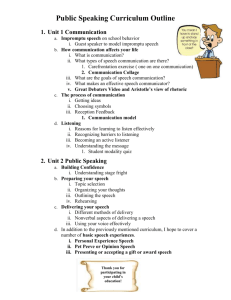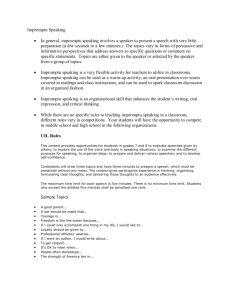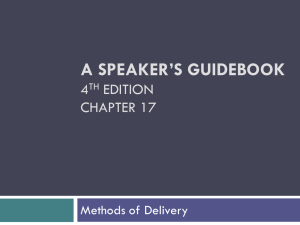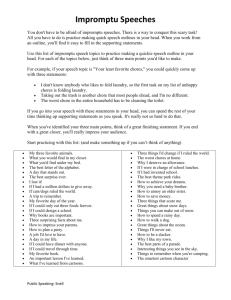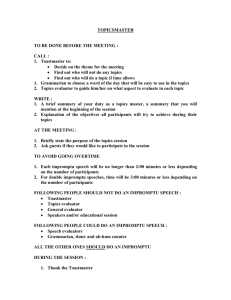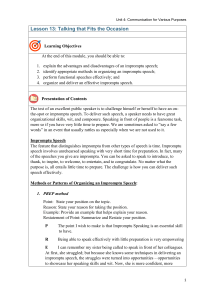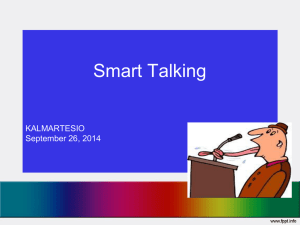Impromptu Speaking
advertisement
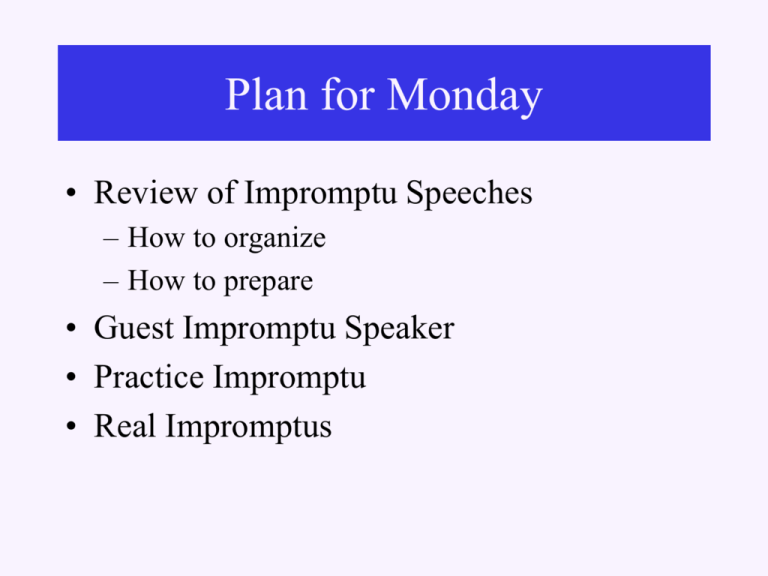
Plan for Monday • Review of Impromptu Speeches – How to organize – How to prepare • Guest Impromptu Speaker • Practice Impromptu • Real Impromptus Impromptu Speaking “It takes three weeks to prepare a good impromptu speech.” -Mark Twain Public Speaking • 2 Messages in a Speech: – Message delivered by speaker – Message received by listener • Goal of Speaker--intended message is clearly communicated • How message is received by audience: – Depends on Verbal Message (what speaker says) – Depends on Non-Verbal Message (how it is said) Organize the Message • Identify Purpose and Goal – Why a speech? – What do you hope to accomplish? – Inform? Persuade? Instruct? • Identify Central Idea – Must be relevant to audience: Why should they listen? – Not overly broad Select Purpose & Central Idea • Choose 2-3 Points – Reinforce your Central Idea – Highlight Central Idea through Examples **IMPORTANT** • Plan Intro & Conclusion – Intro audience to topic – Reiterate Central Idea at end – EASY TO OVERLOOK CONCLUSION Select Purpose & Central Idea Example 1 Specific Purpose: To inform my audience about the major uses of hypnosis. Central Idea: Major uses of hypnosis are to control pain in surgery, help people stop smoking and help students improve their academic performance. Example 2 Specific Purpose: To persuade my audience that online voting should not be approved. Central Idea: We should not approve online voting because it will increase voter fraud and disfranchise voters without Internet access. Scripting Body of Speech Choose 2-3 Main Points • Balance Main Points • Distinguish Sub-points • Use Stories & Examples Scripting Body of Speech Organize Main Points • Chronological Narrate a sequence of events, explain a process • Spatial Follow a directional pattern--top to bottom, left to right • Causal or Problem-Solution Shows a cause-effect relationship or issue-resolution • Topical Divides into sub-topics Transitions Show relationship between language, cue audience and enhance flow of speech • First, second, third… • Now that you understand the problem, I want to tell you about a solution… • In contrast to…; Similar to the first point… • Maybe you are wondering…. • The key to this point is… • The bottom line is… Plan Introduction & Conclusion • Introduction – – – – – Get Attention! State your purpose Relate to your audience Establish credibility Preview your main points • Conclusion – Cue the end – Review your main points or central idea – Vivid ending Final Tips on Delivery • Don’t rush your introduction • Make eye contact with your audience before you begin to speak • Smile, look happy to be here • Pause at transitions • Sell this topic as exciting Practice Speeches • Pair off with a Neighbor & prepare a speech • Each person should pull a topic from the basket • Outline an Impromptu Speech – Identify 2-3 points – How will you introduce points? – How will you conclude?

